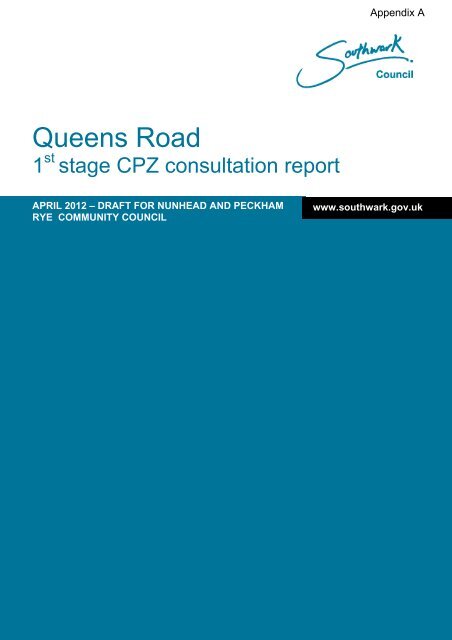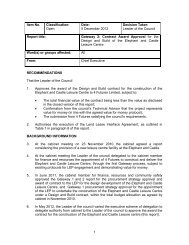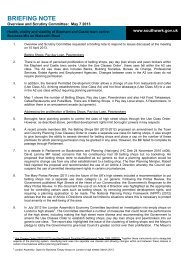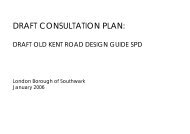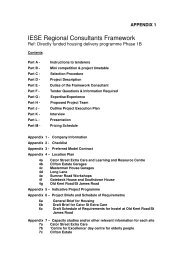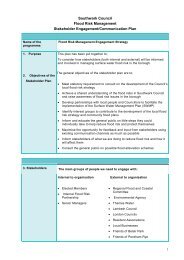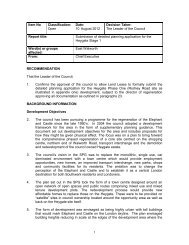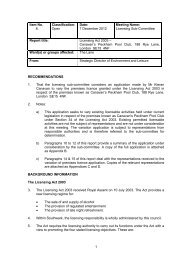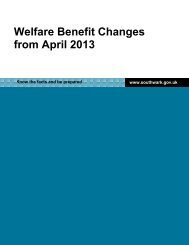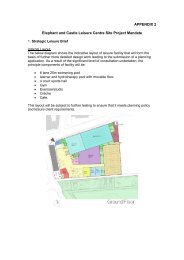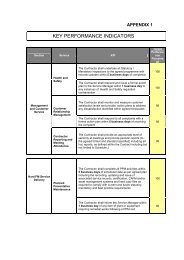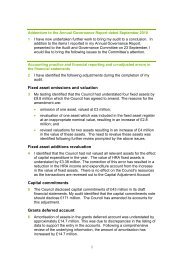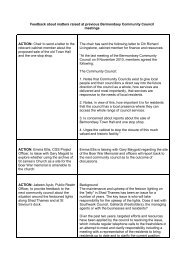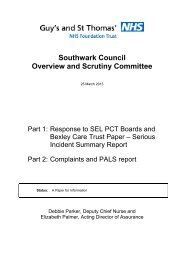Queens Road CPZ consultation report - Meetings, agendas, and ...
Queens Road CPZ consultation report - Meetings, agendas, and ...
Queens Road CPZ consultation report - Meetings, agendas, and ...
You also want an ePaper? Increase the reach of your titles
YUMPU automatically turns print PDFs into web optimized ePapers that Google loves.
Appendix A<br />
<strong>Queens</strong> <strong>Road</strong><br />
1 st stage <strong>CPZ</strong> <strong>consultation</strong> <strong>report</strong><br />
APRIL 2012 – DRAFT FOR NUNHEAD AND PECKHAM<br />
RYE COMMUNITY COUNCIL<br />
www.southwark.gov.uk
Appendix A<br />
<strong>Queens</strong> <strong>Road</strong><br />
1 st stage <strong>CPZ</strong> <strong>consultation</strong> <strong>report</strong><br />
April 2012<br />
www.southwark.gov.uk<br />
This <strong>report</strong> details the findings of a study on the possibility of introducing parking controls in the<br />
<strong>Queens</strong> <strong>Road</strong>, Peckham area. It provides the evidence base for the associated key decision<br />
<strong>report</strong> which sets out recommendations for the cabinet member for transport, environment <strong>and</strong><br />
recycling.<br />
Section A – Introduction <strong>and</strong> policy context.......................................................................................... 3<br />
Section B – Study methods <strong>and</strong> decision making................................................................................. 5<br />
Background of study.....................................................................................................................................5<br />
History of parking <strong>consultation</strong>s in the area ..............................................................................................5<br />
Project structure ............................................................................................................................................6<br />
Consultation area ..........................................................................................................................................7<br />
Existing parking arrangements in the <strong>Queens</strong> <strong>Road</strong> <strong>consultation</strong> area..................................................9<br />
Consultation document...............................................................................................................................10<br />
Further information .....................................................................................................................................11<br />
Parking surveys ...........................................................................................................................................11<br />
Section C – Consultation area questionnaire results summary ........................................................ 12<br />
Summary of response rate .........................................................................................................................12<br />
Headline <strong>consultation</strong> results.....................................................................................................................14<br />
Communications made outside of the freepost or online questionnaire ..............................................24<br />
Stakeholder communication.......................................................................................................................24<br />
Section D – Parking stress survey summary....................................................................................... 25<br />
Headline results ...........................................................................................................................................25<br />
Section E – Study conclusions <strong>and</strong> recommendations...................................................................... 27<br />
<strong>Queens</strong> <strong>Road</strong> study area recommendations ............................................................................................28<br />
List of figures.......................................................................................................................................... 29<br />
List of appendices .................................................................................................................................. 29<br />
Version control ....................................................................................................................................... 29<br />
- 2 -
Appendix A<br />
Section A – Introduction <strong>and</strong> policy context<br />
Southwark Council has twenty one Controlled Parking Zones (<strong>CPZ</strong>s) in operation (appendix 1) which<br />
have been introduced over a period of almost 40 years. This time span reflects the historical <strong>and</strong><br />
continued challenge, faced by every local authority, in matching the dem<strong>and</strong> by drivers to park their cars<br />
with a finite supply of on-street parking spaces.<br />
The Parking <strong>and</strong> Enforcement Plan 1 (PEP) sets out the council’s policy in the management of parking on<br />
its public highway. The PEP acknowledges that few things polarise public opinion more than parking but<br />
that restrictions, in many areas of the borough, provide a critical tool in prioritising space in favour of<br />
certain groups (e.g. blue badge holders, residents or loading) as well as assisting in keeping the traffic<br />
flowing <strong>and</strong> improving road safety.<br />
The PEP was adopted as a supporting document to the council’s 2006 transport strategy, the Local<br />
Implementation Plan 2 (LIP) which has recently been revised, consulted upon <strong>and</strong> adopted as the<br />
Transport Plan 3 .<br />
The Transport Plan, incorporating Southwark’s Local implementation plan (Lip), is a statutory document,<br />
prepared under Section 145 of the Greater London Authority Act 1999. Southwark’s Transport Plan<br />
responds to the revised Mayor’s Transport Strategy (MTS), the Sub Regional Transport Plans (SRTPs),<br />
Southwark’s Sustainable Community Strategy (SCS) <strong>and</strong> other relevant policies.<br />
Amongst its eight key objectives, the Transport Plan sets out the council’s aim to “encourage sustainable<br />
travel choices” <strong>and</strong> “reduce the impact of transport on the environment”.<br />
The plan sets a target to reduce traffic levels by 3% by 2013.<br />
The Transport Plan states “the council supports the introduction of <strong>CPZ</strong>s as an important traffic dem<strong>and</strong><br />
management tool. <strong>CPZ</strong>s do not provide long-stay parking for commuters <strong>and</strong> therefore existing zones<br />
assist in reducing car trips within those zones as well as trips across <strong>and</strong> through the borough”.<br />
1 http://www.southwark.gov.uk/Uploads/FILE_42772.pdf<br />
2 http://www.southwark.gov.uk/YourServices/transport/lip/<br />
3 http://www.southwark.gov.uk/info/200107/transport_policy/1947/southwark_transport_plan_2011<br />
- 3 -
Appendix A<br />
It continues that “parking controls are also significant in releasing suppressed dem<strong>and</strong> for sustainable<br />
modes, such as walking, cycling <strong>and</strong> public transport.”<br />
It is important to recognise that the majority of households in Southwark do not have access to a car <strong>and</strong><br />
the needs of this majority must also be considered in the allocation of street space.<br />
Parking is the end result of a trip. The availability of parking at a destination has a clear effect on whether<br />
the trip is made by car or not. Existing parking controls all across Southwark already assist in improving<br />
traffic <strong>and</strong> congestion levels.<br />
The council has a duty 4 to provide suitable <strong>and</strong> adequate parking facilities on <strong>and</strong> off the highway as<br />
well as securing “the expeditious, convenient <strong>and</strong> safe movement of vehicular <strong>and</strong> other traffic (including<br />
pedestrians)”.<br />
Southwark’s roads provide a finite supply of parking space, limited by various existing measures for<br />
example to: improve safety (eg. pedestrian crossings), reduce congestion (eg. yellow lines), improve<br />
public journey times (eg. bus lanes) or encourage cycling (eg. cycle lanes).<br />
The remaining space can generally be used for parking but in areas where exceeds supply the<br />
prioritisation of that remaining kerb space becomes essential.<br />
In practice, the council prioritises that remaining space through the introduction of <strong>CPZ</strong>s as well as the<br />
installation of local parking restrictions outside of those zones, to manage local parking <strong>and</strong> loading<br />
requirements.<br />
4 <strong>Road</strong> Traffic Regulation Act, 1984, <strong>and</strong> Traffic Management Act, 2004<br />
- 4 -
Appendix A<br />
Section B – Study methods <strong>and</strong> decision making<br />
Background of study<br />
The Parking Enforcement Plan (PEP) refers generally to this area as <strong>Queens</strong> <strong>Road</strong>. It suggests the area<br />
“may justify consideration of new zone” on the basis that it is close to a rail station with a mix of<br />
residential area (with a high density of car ownership per km 2 ) as well as “employers or other attractions<br />
to visit the area”.<br />
The <strong>consultation</strong> area concentrates on streets which are a short walking distance from <strong>Queens</strong> <strong>Road</strong><br />
railway station.<br />
The area was last consulted in 2002 prior to the Congestion Charge being introduced, at that stage there<br />
was no clear level for a <strong>CPZ</strong>.<br />
In recent years, <strong>Queens</strong> <strong>Road</strong> station has seen a large increase in passenger numbers <strong>and</strong> this is<br />
expected to increase further when the London Overground is completed in 2013, connecting through to<br />
Clapham junction <strong>and</strong> beyond.<br />
There have also been a number of new residential <strong>and</strong> commercial developments in the area.<br />
As part of the planning permission for the development on Lugard <strong>Road</strong>, the developer was required to<br />
fund a <strong>consultation</strong> on the option of introducing a <strong>CPZ</strong>. Subsequently, the council has taken the lease of<br />
this building.<br />
History of parking <strong>consultation</strong>s in the area<br />
Date Consultation Outcome<br />
2002 In 2002 the Council commissioned<br />
Project Centre to investigate the need<br />
for <strong>CPZ</strong> centred on <strong>Queens</strong> <strong>Road</strong><br />
Station.<br />
The <strong>consultation</strong> area covered a wide<br />
area around the periphery of <strong>Queens</strong><br />
<strong>Road</strong> rail station with 3278<br />
questionnaires being delivered to<br />
residents <strong>and</strong> businesses in the area.<br />
The <strong>consultation</strong> yielded 287 returns<br />
representing an 8.95% response rate.<br />
A majority of 51% respondents said that they<br />
Never experience parking problems. 34% said<br />
they do experience parking problems during the<br />
day.<br />
60% of respondents voted against parking<br />
controls, with 34% in support.<br />
- 5 -
Appendix A<br />
Project structure<br />
Since adoption of the PEP, the council has generally carried out it’s <strong>CPZ</strong> projects by way of a two-stage<br />
<strong>consultation</strong> process 5 , except where the area limits are predetermined by physical, borough or existing<br />
<strong>CPZ</strong> boundaries or by budget constraints - in which case a joint 1 st /2 nd stage <strong>consultation</strong> may be carried<br />
out.<br />
The two-stage <strong>consultation</strong> approach can be summarised as:<br />
First stage (in principal) <strong>CPZ</strong> <strong>consultation</strong><br />
This stage is to establish where parking problems are occurring <strong>and</strong> at what times it takes place.<br />
A questionnaire is sent out to every property within the area asking for opinions on the principal of a <strong>CPZ</strong><br />
<strong>and</strong> whether or not they experience parking problems. We will also ask our key stakeholders for their<br />
comments too.<br />
Parking occupancy <strong>and</strong> duration surveys are also carried out to analyse who is parking in the area <strong>and</strong><br />
for how long.<br />
Consultation replies <strong>and</strong> parking data are used to make a decision whether or not to introduce a <strong>CPZ</strong> in<br />
the area.<br />
The key decision is taken by the cabinet member for transport, environment <strong>and</strong> recycling but the draft<br />
<strong>report</strong> is made public <strong>and</strong> discussed with the community council before the decision date. This decision<br />
is subject to further 2nd stage (detailed design) <strong>consultation</strong>, see below.<br />
Second stage (detailed design) <strong>CPZ</strong> <strong>consultation</strong><br />
Once a <strong>CPZ</strong> has been approved in principal, we seek views on how the <strong>CPZ</strong> should operate.<br />
During this stage we will consult again on the detail of the zone. For example, we will ask views on the<br />
type <strong>and</strong> position of parking bays, the hours <strong>and</strong> days that the <strong>CPZ</strong> should operate <strong>and</strong> other detailed<br />
parking issues.<br />
A <strong>report</strong> will be discussed with the community council before the cabinet member for transport,<br />
environment <strong>and</strong> recycling approves the final layout, if required.<br />
More detail of the first stage process is shown in Figure 1.<br />
A draft version of this <strong>report</strong> will be presented to the relevant community council prior to a decision being<br />
taken. Opportunity for comment will be made at that meeting <strong>and</strong> those representations will be<br />
appended alongside this <strong>report</strong> <strong>and</strong> the key decision.<br />
5 http://www.southwark.gov.uk/YourServices/transport/parking/cpzreviews/<strong>CPZ</strong>_how_consult/<br />
- 6 -
Appendix A<br />
Consultation area<br />
The draft <strong>consultation</strong> methods <strong>and</strong> boundaries was discussed with ward members <strong>and</strong> approved by the<br />
Planning Committee in September <strong>and</strong> November 2009, respectively.<br />
The streets approved for <strong>consultation</strong> are situated Nunhead Ward.<br />
- 7 -
Appendix A<br />
Figure 1<br />
Addendum – decision changed from strategic director to cabinet member on 25/5/11<br />
- 8 -
Appendix A<br />
Existing parking arrangements in the <strong>Queens</strong> <strong>Road</strong> <strong>consultation</strong> area<br />
Parking within the <strong>consultation</strong> area is predominantly uncontrolled but there are some restrictions that<br />
that prevent kerb-side parking. These are summarised as:<br />
Existing restrictions within the <strong>consultation</strong> area<br />
that prevent kerb-side parking<br />
Location<br />
• Origin disabled bays<br />
17 installed throughout area, outside residents<br />
(outside residents homes who meets the council’s criteria) homes<br />
• School keep clear markings<br />
Hollydale <strong>Road</strong><br />
(marking to prevent parking at the school entrance)<br />
• Car club parking bays Lugard <strong>Road</strong><br />
• Local traffic management<br />
(single/double yellow lines to assist in sight lines <strong>and</strong><br />
maintain traffic flow)<br />
• Vehicle crossovers allow access to private l<strong>and</strong> (ie<br />
residential front driveways) parking is generally<br />
permitted but it can be enforced against by the<br />
council at request of the l<strong>and</strong>owner (certain conditions<br />
apply)<br />
• Dropped kerbs / raised footways – informal crossing<br />
points installed to assist pedestrian to cross the road<br />
<strong>and</strong> where parking is unlawful.<br />
Throughout the area there are local parking<br />
restrictions on some (but not all) junctions.<br />
Various locations throughout the area.<br />
Various locations throughout <strong>consultation</strong> area.<br />
The above controls operate within the <strong>consultation</strong> area <strong>and</strong> are mapped in appendix 2. Additionally, the<br />
existing Peckham (B) <strong>CPZ</strong> is located nearby <strong>and</strong> will have influence upon the supply of on-street parking<br />
through the effects of displacement.<br />
It should be noted that <strong>CPZ</strong>s further afield, are also likely to play a part in impacting upon supply of onstreet<br />
parking. <strong>CPZ</strong>s in the north of Southwark (<strong>and</strong> across all central London authorities) prevent longstay<br />
parking where motorists may otherwise choose to park <strong>and</strong> continue their journey on-foot to work.<br />
These other London <strong>CPZ</strong>s are extensive in their area (covering all of transport Zone 1 <strong>and</strong> most of Zone<br />
2) <strong>and</strong> provide protection to local residents; this may result in some motorists choosing to drive to outer<br />
rail stations or to locations that are adjacent to bus routes <strong>and</strong> then continuing on their journey by train or<br />
bus.<br />
- 9 -
Appendix A<br />
Consultation document<br />
896 postal addresses are located within the <strong>Queens</strong> <strong>Road</strong> <strong>consultation</strong> area. This data was derived from<br />
the council’s Local L<strong>and</strong> <strong>and</strong> Property Gazetteer (LLPG).<br />
Distribution of the <strong>consultation</strong> documents (appendix 3) was made on 3 November 2011 by way of a<br />
blanket h<strong>and</strong>-delivery to all (residential <strong>and</strong> commercial) properties within the <strong>consultation</strong> area. The<br />
delivery was carried out by officers in the parking projects team.<br />
The document was also sent to key <strong>and</strong> local stakeholders. Local stakeholders were identified as the<br />
cabinet member for environment, transport <strong>and</strong> recycling, ward members, Metropolitan Police Service,<br />
London Ambulance Service, London Fire Brigade, Transport for London, internal council teams <strong>and</strong><br />
transport user groups.<br />
The document was designed to present information on:<br />
• why the <strong>consultation</strong> was being carried out<br />
• how recipients could contribute / decision making<br />
• what the 1 st stage <strong>CPZ</strong> <strong>consultation</strong> was about<br />
• Southwark’s policy in regard to <strong>CPZ</strong><br />
• frequently asked questions<br />
• <strong>consultation</strong> map<br />
By way of a questionnaire, the document sought the recipient’s details <strong>and</strong> views on:<br />
• their address<br />
• How may vehicles they park on-street<br />
• current ability to park<br />
• when problems occur<br />
• whether they want controlled parking introduced in their street<br />
• whether their opinion would change if a <strong>CPZ</strong> was introduced in an adjacent street<br />
• any other comments<br />
The document followed Southwark’s communications guidelines <strong>and</strong> provided detail on large print<br />
versions <strong>and</strong> translation services.<br />
The questionnaire could be returned in a provided freepost envelope to the council’s offices or<br />
completed online via Southwark’s <strong>consultation</strong> webpage.<br />
Documents were delivered on 3 November 2011 <strong>and</strong> the response period ran until 25 November 2011.<br />
Officers accepted <strong>and</strong> inputted responses up to 28 November 2011.<br />
Additionally, details of a phone number <strong>and</strong> email address were provided to those receiving the<br />
document should they wish to talk to an officer or email their comments. In those cases, officers<br />
- 10 -
Appendix A<br />
provided assistance <strong>and</strong> advised residents that they should also complete their questionnaire as data<br />
from this formed the main basis of the results analysis.<br />
Further information<br />
25 street notices were erected within the <strong>consultation</strong> area (appendix 4) on 4 November 2011. A copy of<br />
the street notices can be found in appendix 5. The notice provided contact details (telephone <strong>and</strong> email)<br />
for more detail on the <strong>consultation</strong> <strong>and</strong> advice of what to do if <strong>consultation</strong> packs had not been received.<br />
The council’s parking <strong>consultation</strong> webpage 6 was also updated with detail of the active <strong>consultation</strong>, its<br />
process <strong>and</strong> how decisions would be taken. A selection of frequently asked questions in relation to<br />
<strong>CPZ</strong>s also provided an additional source of information for those making enquiries as to what a <strong>CPZ</strong><br />
could mean to them.<br />
As mentioned above, a direct phone number <strong>and</strong> email address to the parking projects team was made<br />
available to allow those wishing to making enquires via those methods. Officers assisted with response<br />
<strong>and</strong> also recommended that the callers complete their questionnaire.<br />
Parking surveys<br />
To quantify the parking situation, Count on Us were commissioned to undertake parking surveys on a<br />
weekday, Wednesday 8 June 2011 <strong>and</strong> a weekend, Saturday 11 June 2011 to ascertain parking<br />
occupancy <strong>and</strong> duration of stay on all public highway roads within the <strong>consultation</strong> area. A summarised<br />
version of the parking beat surveys can be found in appendix 6.<br />
6 http://www.southwark.gov.uk/info/200140/parking_projects<br />
- 11 -
Appendix A<br />
Section C – Consultation area questionnaire results summary<br />
Summary of response rate<br />
Figure 2 shows that the <strong>Queens</strong> <strong>Road</strong> <strong>consultation</strong> yielded 142 returned questionnaires from within the<br />
<strong>consultation</strong> area, representing a 16% response rate. This is an adequate response rate for this type of<br />
<strong>consultation</strong> when compared with similar <strong>consultation</strong>s in the borough <strong>and</strong> benchmarked against other<br />
London authorities.<br />
The highest response rate was from Consort <strong>Road</strong> <strong>and</strong> Hathrone Close (33%), the lowest were Nazareth<br />
Gardens, <strong>Queens</strong> <strong>Road</strong>, Shelley Close, <strong>and</strong> Sunwell Close with no responses. Figure 2.1 provides a<br />
graph of each streets response rate.<br />
The PEP sets out that the council will give significant weight to the <strong>consultation</strong> return when it exceeds a<br />
20% threshold. In accordance with the PEP, other local information sources (such as quantitative<br />
parking studies, future development, likely impact of surrounding parking controls <strong>and</strong> community council<br />
opinion) should be given greater weighting where the threshold is not reached.<br />
Street<br />
Consultation packs<br />
distributed<br />
Questionnaires<br />
returned<br />
Response<br />
Rate<br />
BRAYARDS ROAD 119 22 18%<br />
CAULFIELD ROAD 58 5 9%<br />
CONSORT ROAD 3 1 33%<br />
CROSS CLOSE 19 2 11%<br />
EVAN COOK CLOSE 146 16 11%<br />
FIRBANK ROAD 35 5 14%<br />
GORDON ROAD 96 10 10%<br />
HARDERS ROAD 6 1 17%<br />
HATHORNE CLOSE 12 4 33%<br />
HOLLYDALE ROAD 65 15 23%<br />
KIRKWOOD ROAD 77 19 25%<br />
LUGARD ROAD 118 29 25%<br />
MAYA CLOSE 18 1 6%<br />
NAZARETH GARDENS 42 0 0%<br />
QUEENS ROAD 6 0 0%<br />
SHELLEY CLOSE 6 0 0%<br />
STANBURY ROAD 48 12 25%<br />
SUNWELL CLOSE 22 0 0%<br />
TOTAL 896 142 16%<br />
Figure 2<br />
A further 11 comments were made either by email, letter or phone.<br />
The options <strong>and</strong> recommendations are based on feedback received from the public <strong>consultation</strong> in<br />
conjunction with objective analysis of occupancy data from parking stress surveys.<br />
- 12 -
Appendix A<br />
Response Rate<br />
Overall response rate<br />
25%<br />
0%<br />
0% 0% 0%<br />
SUNWELL CLOSE<br />
STANBURY ROAD<br />
SHELLEY CLOSE<br />
18%<br />
9%<br />
33%<br />
11% 11%<br />
14%<br />
10%<br />
Response Rate<br />
Figure 2.1<br />
33%<br />
17%<br />
23% 25% 25% 6%<br />
HATHORNE CLOSE<br />
HOLLYDALE ROAD<br />
KIRKWOOD ROAD<br />
LUGARD ROAD<br />
MAYA CLOSE<br />
NAZARETH GARDENS<br />
QUEENS ROAD<br />
HARDERS ROAD<br />
EVAN COOK CLOSE<br />
FIRBANK ROAD<br />
GORDON ROAD<br />
CONSORT ROAD<br />
CROSS CLOSE<br />
CAULFIELD ROAD<br />
35%<br />
30%<br />
25%<br />
20%<br />
15%<br />
10%<br />
5%<br />
0%<br />
Street<br />
- 13 -<br />
BRAYARDS ROAD
Appendix A<br />
Headline <strong>consultation</strong> results<br />
1) 75% of questionnaires were returned by post <strong>and</strong> 25% submitted online.<br />
2) It is worth noting that 2 duplicate responses have been omitted from the analysis. A duplicate is<br />
where a response, from the same property address, was submitted twice, by post <strong>and</strong> online.<br />
3) The duplicates were received from Gordon <strong>Road</strong> <strong>and</strong> Kirkwood <strong>Road</strong>.<br />
Q1) Are you a resident or business<br />
4) 97% of responses were received from residential properties. Based upon OS l<strong>and</strong> use survey<br />
data this is reasonably representative of the area, which is predominately residential with<br />
exception of <strong>Queens</strong> <strong>Road</strong> that contains a number of retail <strong>and</strong> commercial business properties.<br />
5) 2% of responses came from businesses, <strong>and</strong> 1% from ‘both’.<br />
Q2) How many vehicles do you park on the road?<br />
6) The majority of respondents have access to one vehicle. Only 12.7% of respondents in the study<br />
area don’t have a vehicle. This response is unrepresentative for the London Borough of<br />
Southwark (51.9%) – although these figures are based on 2001 census data. This may reflect<br />
the fact that car users are more likely to respond than non-users as they perceive themselves as<br />
more directly affected.<br />
7) 71.1% of respondents park one vehicle on the public highway, detailed in Figure 3.<br />
80.0%<br />
70.0%<br />
71.1%<br />
60.0%<br />
50.0%<br />
40.0%<br />
30.0%<br />
20.0%<br />
10.0%<br />
0.0%<br />
12.7%<br />
11.3%<br />
4.2%<br />
1%<br />
I don't have a vehicle None, I park off-street 1 2 or more No answer<br />
Figure 3<br />
- 14 -
Appendix A<br />
Q3) Please rate the ability to find an on-street parking space near this address?<br />
8) Across the whole <strong>consultation</strong> area, when asked about your ability to find an on-street parking<br />
space: 68% found it easy or easy/moderate, 16% found it moderate/difficult or difficult. The<br />
results were similar for visitor parking (70% easy or easy/moderate v 18% moderate/difficult or<br />
difficult). Figure 4<br />
9) Gordon <strong>Road</strong> (70%) showed the highest proportion of respondents rating their ability to find an<br />
on-street parking space near their address as moderate/difficult or difficult.<br />
10) Brayards <strong>Road</strong>, Lugard <strong>Road</strong> <strong>and</strong> Kirkwood <strong>Road</strong> showed the highest proportion of respondents<br />
rating their ability to find an on-street parking space near their address as easy or easy/moderate.<br />
90<br />
80<br />
70<br />
79<br />
77<br />
You<br />
Your Visitors<br />
60<br />
50<br />
40<br />
30<br />
20<br />
10<br />
18<br />
22<br />
15<br />
8 8<br />
9<br />
14<br />
16<br />
0<br />
Easy<br />
Easy/Moderate<br />
Moderate<br />
Moderate/Difficult<br />
Difficult<br />
Figure 4<br />
- 15 -
Appendix A<br />
Q4) What time of day do you or your visitors have difficulty parking?<br />
11) Question 4 was provided to ascertain when respondents most felt parking difficulties occurred.<br />
Figure 5 details the overall responses. The largest response group expressed that they never<br />
experienced parking problems. The second largest group said that problems occurred during the<br />
weekday evenings, followed by weekday daytime. The table provides a count of the top three<br />
responses from each option. Respondents could select as many or few times periods as they<br />
considered appropriate.<br />
Monday – Friday, daytime<br />
Monday – Friday, evening<br />
Saturday<br />
Sunday<br />
Never<br />
You<br />
7 – Gordon <strong>Road</strong><br />
7 – Hollydale <strong>Road</strong><br />
4 – Lugard <strong>Road</strong><br />
8 – Evan Cook Close<br />
5 – Gordon <strong>Road</strong><br />
4 – Kirkwood <strong>Road</strong> <strong>and</strong> Lugard <strong>Road</strong><br />
5 – Gordon <strong>Road</strong><br />
4 – Hollydale <strong>Road</strong><br />
3 – Kirkwood <strong>Road</strong> <strong>and</strong> Lugard <strong>Road</strong><br />
4 – Gordon <strong>Road</strong><br />
2 – Hollydale <strong>Road</strong><br />
1 – Kirkwood <strong>Road</strong> <strong>and</strong> Lugard <strong>Road</strong><br />
14 – Brayards <strong>Road</strong><br />
14 – Lugard <strong>Road</strong><br />
10 – Stanbury <strong>Road</strong><br />
Your visitors<br />
8 – Hollydale <strong>Road</strong><br />
7 – Lugard <strong>Road</strong><br />
5 – Gordon <strong>Road</strong><br />
5 – Evan Cook Close<br />
5 – Gordon <strong>Road</strong><br />
5 – Lugard <strong>Road</strong><br />
6 – Gordon <strong>Road</strong><br />
5 – Lugard <strong>Road</strong><br />
3 – Hollydale <strong>Road</strong><br />
5 – Gordon <strong>Road</strong><br />
2 – Hollydale <strong>Road</strong><br />
2 – Kirkwood <strong>Road</strong><br />
15 – Brayards <strong>Road</strong><br />
15 – Lugard <strong>Road</strong><br />
11 – Stanbury <strong>Road</strong><br />
80<br />
76<br />
70<br />
You<br />
Your visitors<br />
69<br />
60<br />
50<br />
40<br />
30<br />
20<br />
10<br />
27<br />
28 29<br />
27<br />
20<br />
22<br />
10<br />
12<br />
0<br />
Monday - Friday<br />
daytime<br />
Monday - Friday<br />
evening<br />
Saturday Sunday Never<br />
Figure 5<br />
- 16 -
Appendix A<br />
Q5) Do you want controlled parking to be introduced in your street?<br />
12) The key question of “do you agree with the proposed introduction of a <strong>CPZ</strong> in your street?” is<br />
tabulated for the entire <strong>consultation</strong> area in Figure 6, graphed in Figure 6.1 <strong>and</strong> individual<br />
responses mapped on a street-by-street bases in Figure 6.2.<br />
Response Overall total Percentage<br />
No 113 79.6%<br />
Yes 24 16.9%<br />
Undecided 5 3.5%<br />
17%<br />
4%<br />
No<br />
Yes<br />
Undecided<br />
79%<br />
Do you want controlled parking introduced in your street?<br />
Yes<br />
Street No No% Undecided Undecided % Yes %<br />
Total<br />
returned<br />
Response Rate<br />
Total<br />
delivered<br />
Response<br />
Rate<br />
Brayards <strong>Road</strong> 22 100% 0 0% 0 0% 22 119 18%<br />
Caulfield <strong>Road</strong> 4 80% 1 20% 0 0% 5 58 9%<br />
Consort <strong>Road</strong> 0% 0 0% 1 100% 1 3 33%<br />
Cross Close 2 100% 0 0% 0 0% 2 19 11%<br />
Evan Cook Close 10 63% 3 19% 3 19% 16 146 11%<br />
Firbank <strong>Road</strong> 5 100% 0 0% 0 0% 5 35 14%<br />
Gordon <strong>Road</strong> 3 30% 1 10% 6 60% 10 96 10%<br />
Harders <strong>Road</strong> 1 100% 0 0% 0 0% 1 6 17%<br />
Hathorne Close 3 75% 0 0% 1 25% 4 12 33%<br />
Hollydale <strong>Road</strong> 10 67% 0 0% 5 33% 15 65 23%<br />
Kirkwood <strong>Road</strong> 16 84% 0 0% 3 16% 19 77 25%<br />
Lugard <strong>Road</strong> 24 83% 0 0% 5 17% 29 118 25%<br />
Maya Close 1 100% 0 0% 0 0% 1 18 6%<br />
Nazareth<br />
Gardens 0 0% 0 0% 0 0% 0 42 0%<br />
<strong>Queens</strong> <strong>Road</strong> 0 0% 0 0% 0 0% 0 6 0%<br />
Shelley Close 0 0% 0 0% 0 0% 0 6 0%<br />
Stanbury <strong>Road</strong> 12 100% 0 0% 0 0% 12 48 25%<br />
Sunwell Close 0 0% 0 0% 0 0% 0 22 0%<br />
Gr<strong>and</strong> Total 113 79.6% 5 3.5% 24 16.9% 142 896 16%<br />
Figure 6<br />
- 17 -
100%<br />
80%<br />
60%<br />
40%<br />
20%<br />
0%<br />
1<br />
22<br />
1<br />
2<br />
4<br />
3<br />
3<br />
10<br />
5<br />
6<br />
1<br />
1<br />
3<br />
1<br />
3<br />
5<br />
10<br />
3 5<br />
16 24<br />
1 12<br />
Yes<br />
Undecided<br />
No<br />
Brayards <strong>Road</strong><br />
Caulfield <strong>Road</strong><br />
Consort <strong>Road</strong><br />
Cross Close<br />
Evan Cook Close<br />
Firbank <strong>Road</strong><br />
Gordan <strong>Road</strong><br />
Harders <strong>Road</strong><br />
Hathorne Close<br />
Hollydale <strong>Road</strong><br />
Kirkwood <strong>Road</strong><br />
Lugard <strong>Road</strong><br />
Maya Close<br />
Stanbury <strong>Road</strong><br />
Count of <strong>CPZ</strong>introducedinyourstreet<br />
Streetname<br />
- 18 -<br />
<strong>CPZ</strong>introducedinyourstreet<br />
Figure 6.1<br />
Appendix A
Appendix A<br />
Figure 6.2<br />
- 19 -
Appendix A<br />
Q6) Would you change your mind if a <strong>CPZ</strong> was introduced in street next to yours?<br />
13) Those persons who responded that they didn’t want or were undecided on a <strong>CPZ</strong> in their street<br />
were asked a further question 7 if they would change their mind if a <strong>CPZ</strong> was to be introduced in<br />
an adjacent street.<br />
14) Figure 7 details the responses. The majority (72%) would not change their mind <strong>and</strong> wanted to<br />
keep their street uncontrolled even if a <strong>CPZ</strong> was introduced into an adjacent street.<br />
15) Only Evan Cook Close stated that they would change their mind, as shown in Figure 7.1.<br />
10%<br />
No<br />
Undecided<br />
Yes<br />
18%<br />
72%<br />
Figure 7<br />
Q6 No Undecided Yes<br />
Evan Cook Close 5 (38%) 2 (15%) 6 (46%)<br />
Figure 7.1<br />
7 Those persons completing the paper copy of the questionnaire were able to answer this Q6 even if they had said “yes” to Q5.<br />
As their views were not relevant in analysing Q6 we have deleted their responses from the results in this question section.<br />
- 20 -
Appendix A<br />
Q7) Please let us know any other comments you have about this proposal or the <strong>consultation</strong>?<br />
16) Finally, other comments were sought. Underst<strong>and</strong>ably, the responses given generally mirrored<br />
the view expressed to the key question of whether a <strong>CPZ</strong> was wanted or not. Figure 8 provides<br />
the comments from those in support of controls. Figure 9 provides the comments from those<br />
against controls.<br />
Figure 8 (comment from those in support of controls)<br />
How about resident parking only<br />
I would like a <strong>CPZ</strong> but only if it truly does become more difficult to park. At the moment parking isn't really an issue, but if it dies increase<br />
substantially, we need to be sure that we will have a space to park our car. I do worry about my family visiti<br />
This is essential to ivnr<strong>and</strong> in this area, the anti-social elements that associate with non-controlled zones near public station is ridiculous<br />
£125 per year for a permit is very expensive as I already pay £80pcm council tax. You will make money from the tickets.<br />
There are too many driving to work <strong>and</strong> parking in Gordon <strong>Road</strong>.<br />
Requested resident should have free permits for their own vehicles & pay for visitors as they are the reason we can never find parking. plus<br />
working people park in our road during the week.<br />
Due to having a garage 2 doors away, the owner parks all his customers cars in our street. We also have commuters parking + shoppers<br />
going to Peckham _ car repairs parking their broken down/damaged cars. Local residents who live in a <strong>CPZ</strong> park their cars<br />
Gordon <strong>Road</strong> needs a proper <strong>CPZ</strong> to stop the car garages on Brayards <strong>Road</strong> dumping cars on the road for weeks- Taking up residence<br />
spaces.<br />
My support for the proposal is contingent on the 3 local car mechanics not being issued parking permits which allow them to continue to<br />
park numerous cars awaiting repair on the public highway. If a business permit allows the mechanics to park, for example<br />
Too many cars <strong>and</strong> lorries parking in cul-de-sac of Hathorne Close, due to garage <strong>and</strong> shops being nearby.<br />
You can never get a park out side your house, day night weekends it is like a nightmare trying to find somewhere to park on the road<br />
This is long overdue. The irony that a number of commuter cars have their own parking permits for different boroughs (or even towns) is not<br />
lost on me. Plus, since the development on Evan Cook Close, parking has been a lot more difficult. The council's<br />
Ideally, a controlled zone is useful mostly between Mon-Fri weekend is normally ok. Mon0Fri 08:00 - 16:00 is what i would think is ideal<br />
Why are the charges (for both residents <strong>and</strong> visitors) so high? What are 2nd visitors permits so much more expensive for the 2nd &<br />
subsequent books?<br />
I think the whole idea of introducing <strong>CPZ</strong> was a very good idea. More parking spaces, lack of argument over parking space. Payment<br />
scheme law enforcement for protection should securities for residents<br />
People from other areas comes round <strong>and</strong> block my driveway all the time<br />
People park on our street then go to <strong>Queens</strong> Rd st (trains) not right noise of engines - music.<br />
This needs to be in place ASAP before <strong>Queens</strong> <strong>Road</strong> station runs additional services <strong>and</strong> before the council move into new offices.<br />
Parking at this end of Lugard <strong>Road</strong> is only going to become more problematic with the arrival of the Tube extension + Southwark offices at<br />
the of <strong>Queens</strong> <strong>Road</strong> in 2012<br />
I feel resident visitors permit is quite expensive <strong>and</strong> what if you don't used 10 parking permit in that year<br />
Will my visitors walow to park on my white line without penalty<br />
- 21 -
Appendix A<br />
Figure 9 (comment from those against controls)<br />
<strong>CPZ</strong> totally unnecessary<br />
a <strong>CPZ</strong> does not guarantee a parking space for mine or my visitors vehicles this is just a way of getting easy money out of us by the local<br />
council I do not want a cpz anywhere near me thank you<br />
There is not a parking problem in this area what so ever so absolutely no need other than to make common revenue<br />
There has never been a problem parking in this area <strong>and</strong> I do not foresee that the new office building will cause as many parking problems<br />
as the <strong>consultation</strong> documents suggest. Parking restrictions would financially penalise residents without offering the<br />
I think it's a ridiculous proposal. I am outraged that it's even been thought of.<br />
free parking please<br />
I am 81 years old <strong>and</strong> disabled <strong>and</strong> cannot walk far, my car is my only means of transport, I am struggling to pay the bills as it is, without<br />
more on top.<br />
It is so nice to live in a place without controlled parking. Must the council control an ever - increasing area for parking? Why not consult on<br />
removing some of the existing restrictions? Looks like revenue - raiser to me. £125 is massive.<br />
I pay enough road tax for my car to be on the street. Their are no circumstance under which I would like my street to be <strong>CPZ</strong><br />
We strongly do not want parking permit, we don't have problem finding a parking space. We don't benefit from this scheme instead its<br />
going to cost us money. I've spoken with all my neighbours <strong>and</strong> all is against it, find some other way to raise your revenue<br />
Neighbours <strong>and</strong> businesses are friendly to each other <strong>and</strong> there are enough space for both. I don't support a change.<br />
We do not need controlled parking in this area as it has nothing to do with the flow of traffic <strong>and</strong> we now this idea is only to take extra<br />
money from us. Will you please leave it as it is. Thank you<br />
The <strong>consultation</strong> is good but my road should not be included in your <strong>CPZ</strong> map. My road is far from <strong>Queens</strong> <strong>Road</strong>. Is this exercise just to<br />
control traffic or another way of making money.<br />
<strong>CPZ</strong> in this area is wrong because we don't have no parking problem. This is just a way to squeeze more money out of us. Business is low<br />
as it is <strong>and</strong> the will kill me even more.<br />
It's clear there is no need for restricted parking in this area. Even living adjacent to two local shops, whose customers need to be able to<br />
park nearby, neither my visitors nor I ever have significant problems parking here. Local businesses would suffer,<br />
I don't want a <strong>CPZ</strong> introduced around here - It will make things worse for everyone in all respects.<br />
Brayards <strong>Road</strong> is a quite street which does not need a <strong>CPZ</strong>. The government is just trying to rob the little money left in peoples pockets.<br />
This is just a disgrace & wrong.<br />
Life is hard as it is for everyone especially for small businesses - A <strong>CPZ</strong> will be another nail in the coffin for us <strong>and</strong> businesses alike. It will<br />
also help Tesco express to flourish <strong>and</strong> there a 3 of those around us!<br />
I think times are financially hard enough introducing permits will only put more pressure on peoples pockets, especially the families that are<br />
not working.<br />
Please stop worries about people pockets, enough is enough The live goes to the Hell Fire.<br />
It's money making, you do not care about people who live here. STOP NO MORE <strong>CPZ</strong> in this area. Thank you.<br />
I do not have problem parking on my street or my area at any time.<br />
We already have these zones surrounding us - parking is fantastic in areas specified by you - We do not need <strong>CPZ</strong>. It will only create<br />
problems.<br />
I completely disagree <strong>and</strong> simply could not afford the additional cost if a <strong>CPZ</strong> were introduced!<br />
I am strongly against the introduction of a <strong>CPZ</strong> near <strong>Queens</strong> <strong>Road</strong> station. It is clearly linked to Southwark Council moving into the offices<br />
on Lugard Rd <strong>and</strong> the need for more parking for Southwark council staff, rather than it being motivated by a need to<br />
Keep it as it is, Southwark built Evan Cook Close with over 150 flats <strong>and</strong> about 15 parking spaces..very clever. the only place residents can<br />
park in on Lugard Rd. If you introduce <strong>CPZ</strong> on any other near by street this will cause congestion here <strong>and</strong> we won'<br />
Parking is OK as it is. No need to change. Sometimes have to park a little further away but I think I would still have to do under <strong>CPZ</strong> <strong>and</strong><br />
have to pay as well.<br />
Really not needed.<br />
Is this proposal a scheme for increasing revenue for the council? There really are no issues with parking in the area <strong>and</strong> the introduction of<br />
this plan in Lugard <strong>Road</strong> or adjacent streets will only cause trouble for residents who will then have to pay to p<br />
Its not a good reason that just because Southwark council are moving in we now have to pay for parking.<br />
I have serious questions <strong>and</strong> concerns about these proposals, as I'm sure many residents will. The leaflet you have provided posits an<br />
'increase in passenger numbers' to <strong>Queens</strong> <strong>Road</strong> station as one of the main reasons for implementing this <strong>consultation</strong> <strong>and</strong><br />
I object to the introduction of a <strong>CPZ</strong> as I don't think there are problems with finding parking spaces currently.<br />
If adjacent roads begin a <strong>CPZ</strong>, this will impact on our ability to park <strong>and</strong> then I might be grateful for a <strong>CPZ</strong> but currently there is no need.<br />
I don't see any problem that currently needs addressing, congestion charge didn't affect us, so I don't think increased use of <strong>Queens</strong> <strong>Road</strong><br />
station will.<br />
I am concerned that visitors to our property are able to park without charge. We have a young son <strong>and</strong> are expecting another baby in<br />
February <strong>and</strong> rely on our family to drive over the look after the children in our house. If charges were introduced for vi<br />
There is no need for <strong>CPZ</strong> in this area as there so many free parking spaces <strong>and</strong> is not busy an area<br />
A lot of residents have children <strong>and</strong> on low income <strong>and</strong> this will not be very good for them as they need their vehicles to do school runs etc.<br />
It is not needed here.<br />
As a self employed individual working at home I regularly have colleagues visiting who require free, easy access parking to unload. My<br />
neighbour owns a garage which similarly benefits from the current free parking available.<br />
It is a quiet residential area where <strong>CPZ</strong> does not bring benefits to residents. It would result in more cars parked in front gardens.<br />
We are a long established local company <strong>and</strong> would not welcome restrictions on local parking. This would only leave large areas of unused<br />
bays <strong>and</strong> crowd other unrestricted streets.<br />
With the current economic climate, charging would be inappropriate. Just an excuse to raise revenues?<br />
If cpz was introduced I would not be too effected as my wife has a blue badge but I would be reluctant to leave the badge in the car in this<br />
quiet street where it could be stolen<br />
There is no need for a controlled zone in this area, there is no problems with parking at all.<br />
In the current economic crisis I think it is diabolical for Southwark to pile more costs onto already destitute residents.<br />
My daughter sometimes come to care for me in the day <strong>and</strong> can't afford to pay <strong>and</strong> display. residents should have free parking like H.A.<br />
schemes<br />
I underst<strong>and</strong> the need for <strong>CPZ</strong> in some areas. We currently haven t problems so I don t see the need. It strikes me that it is not a<br />
- 22 -
Appendix A<br />
coincidence the Council will move into the offices opposite <strong>Queens</strong> <strong>Road</strong> station soon, bringing parking needs with it, as the<br />
<strong>CPZ</strong> is not needed in Hollydale <strong>Road</strong><br />
I have being living at this address for the pass twenty year <strong>and</strong> I have never have any problem parking.<br />
We have great difficulty parking at present as the local school "St Thomas Acadamy" has new buildings <strong>and</strong> the teacher parking is now<br />
reduced. They now park outside any house. If <strong>CPZ</strong> is introduced there is no guarantee, even after paying that we will have<br />
I see no evidence that this is currently necessary.<br />
The proposed £125 charge for a residents parking permit is outrageous. There is no parking problem in Hollydale <strong>Road</strong>. Making half of it,<br />
or roads around it, a <strong>CPZ</strong> will create one. If there is a <strong>CPZ</strong> finally introduced, the charge for residents <strong>and</strong> busin<br />
The college is having a rebuilding programme + has no car park, our car park will open again in 2012.<br />
Kirkwood, Kimberley <strong>and</strong> Crewys Rd would become extremely congested if the <strong>CPZ</strong> was introduced. Living just outside the boundary I fear<br />
that parking would become very difficult. I would rather be within the zone than just outside it.<br />
Parking is no problem on Kirkwood <strong>Road</strong> at present so ideally I'd like nothing to change. I think when the overground opens at <strong>Queens</strong><br />
<strong>Road</strong> in next year or two then it may be different, If other nearby road become <strong>CPZ</strong> then othat will have an impact on park<br />
As a resident of Kirkwood <strong>Road</strong> for 8 years, I can see no evidence that a <strong>CPZ</strong> is needed in the immediate area. There is ample space for<br />
all car users right now, both in the daytime + evening.<br />
I am quite happy about conditions on this street an have no desire to see things change to make more difficult for me.<br />
I do not object to controlling parking but do strongly object to having to pay to park outside my house<br />
I have not experienced any parking difficulties in my street <strong>and</strong> there always seems to be plenty of parking space available in the<br />
surrounding streets. The introduction of a Controlled Parking Zone is likely to create parking problems rather than solve th<br />
I would like to submit that i would be extremely angry if any of my council tax was spent on this <strong>consultation</strong> process at any stage. I would<br />
be angrier if I subsequently found that parking near my property was made more difficult due to restrictions im<br />
<strong>CPZ</strong> should only be introduced in areas close to transport hubs or shops if the usage of these facilities by motorists results in resident<br />
parking difficulties. If introduced in residential areas that do not have these problems then the charge is purely f<br />
WE don't need <strong>CPZ</strong> in this area, the current situation works very well!<br />
Parking around the junction with Lugard road is not a problem. The excess curb space towards the dead end/rail bridge means I am always<br />
able to park in close proximity to my front door. My visitors have also not <strong>report</strong>ed any parking problems.<br />
They only use it via the station in the day by evening it clear so no <strong>and</strong> I wont change<br />
I can only ask as you are doing this survey is it possible for me to have a disabled bay put outside where I live I am registered disabled <strong>and</strong><br />
this would be a great help to me with parking.<br />
Why people never inform us formally . i shall contact south london press of your immoral ways of been devious to the street of no<br />
information on this act<br />
i do not agree with this proposal because 80% of the cars that park on my road <strong>and</strong> neighbouring roads are from your own council staff that<br />
work on Bournemouth road by 530pm the road is clear <strong>and</strong> even between 9-5 there is still parking available i dont see w<br />
Parking has never been a problem it seems that they only reason for it now is the proposed council officer due to be located in Lugard<br />
<strong>Road</strong>.<br />
I think this is ridiculous. Despite the council tax we pay, road tax, public transport fees you still look for more ways to steal money from us.<br />
You a thienly crooks with a legal umbrella over your head. You are forcing us to say yes what a joke. In the d<br />
I had rented a garage from southwark council for years <strong>and</strong> recently stopped due to it being too expensive, I've been parking on Lugard<br />
<strong>Road</strong> <strong>and</strong> has had no problems finding parking spaces.<br />
Parking has become a problem due to the increased number of residents since the new development of Evan Cook. Also more commuters<br />
are trying to park all day then travel by train from <strong>Queens</strong> <strong>Road</strong> Station.<br />
My mother is 87yrs old <strong>and</strong> although she is not disabled I need my car to drive her where she needs to go. I cannot afford £500 per year<br />
for parking permits <strong>and</strong> will have to get rid of my car which is totally unfair.<br />
I'm not personally affected by parking issues as I rarely take my car out during the week. I think the cost to residents/visitors of the permit<br />
scheme is too high. I don't want to have to pay to park outside my home.<br />
There is no problem with parking on Lugard <strong>Road</strong> no matter what time of day you are looking to Park, totally against a <strong>CPZ</strong> on this road<br />
you <strong>and</strong> your staff going to cost the parking problem the resident should not pay to park there car or van<br />
I would prefer not to pay for parking al all.<br />
This seems to be an expensive booklet to produce at a time of stringent financial cut backs <strong>and</strong> job losses from the council.<br />
I hope we will see some benefits in the councils occupation of the office building at Lugard Rd/<strong>Queens</strong> Rd, <strong>and</strong> not parking issues.<br />
The cost of living <strong>and</strong> my pension would not allow for this, nor would I get visitors to take me shopping or general visits. All my life in Lugard<br />
Rd cannot believe it.<br />
I find the proposal of charging residents to park totally unacceptable.<br />
It will not increase if the council does not introduce so many controlled parking.<br />
A <strong>CPZ</strong> would be internally detrimental to Lugard <strong>Road</strong> <strong>and</strong> other roads in the area. Perhaps a levy could be made on families having more<br />
than one or two vehicles? Not very confident on Southwark node of <strong>consultation</strong>. Whatever has been decided will be impleme<br />
No won at all wants <strong>CPZ</strong> now or in the future - don't upset any of us<br />
Very easy to park, no problem at all because we are not near the shops- buses or trains. No one has any problem parking day or night. we<br />
don't want a <strong>CPZ</strong> we like it that way. I do want your <strong>CPZ</strong> in our very nice road neither do our neighbours. We are not<br />
We are happy the way it is. I don't want any <strong>CPZ</strong> in my area. Thank you. We are not prisoners. Let us be.<br />
We are a 2 car household. I don't want to pay you guys £250=00 a year for something I get now for free. And I don't want to pay guys<br />
£250=00 for painting a few white lines, money for old rope<br />
Stanbury/Lugard/Kirkwood/Caufield/Brayards <strong>Road</strong>s: have had diffuculty parking. We are not in the centre of town. Dem<strong>and</strong> does not<br />
warrant a <strong>CPZ</strong> here. Living in London during financial crisis is difficult enough without this!!<br />
I would like to have a further survey when all the development on Lugard road is fully occupied <strong>and</strong> when the London overground is<br />
completed - These could massively impact parking.<br />
I am concerned that my neighbours who rely on cars <strong>and</strong> vans to do their work will be penalised <strong>and</strong> have to pay to park.<br />
Parking in this area is plentiful + Easy. At a time of austerity forcing households to shell out an extra £141 a year is unacceptable. Even<br />
more so for familes with two or more cars, where a mum, carer, disabled person resides.<br />
It is difficult to pay another bill for the pensioner<br />
This is another way of Southwark council to fleece even more money from us - the public! Your CCTV cars make enough don't they???<br />
As a resident I never have any problem parking - ever. Therefore this is not needed. Waste of time <strong>and</strong> money<br />
I already pay a service charge, this is just another way of an additional tax on motorists.<br />
- 23 -
Appendix A<br />
Communications made outside of the freepost or online questionnaire<br />
Figure 2 displays the type of communication used by all respondents during <strong>consultation</strong>.<br />
For the purposes of analysis, the figures used (unless stated otherwise) are based upon actual<br />
responses to the questionnaire via the freepost or online address. It is noted that when respondents<br />
scanned <strong>and</strong> emailed their responses to the council these have been included in the main questionnaire<br />
dataset.<br />
Whilst inference can be made about the view expressed in an email or letter, for example, the council<br />
are unable to add these figures directly into the questionnaire results. This is to encourage people to<br />
read the information contained within the <strong>consultation</strong> pack, respond to specific questions, avoid risk of<br />
duplication from those persons who respond by more than one method (by email <strong>and</strong> questionnaire, for<br />
example) <strong>and</strong> to avoid misinterpretation by the officer inputting the data.<br />
Communications made outside of the questionnaire responses have been included in this study <strong>and</strong><br />
Figure 10 <strong>and</strong> summarise the main purpose of the correspondence.<br />
Summary of other correspondence received during the <strong>consultation</strong> period.<br />
<strong>Road</strong> Against a <strong>CPZ</strong> Supports a <strong>CPZ</strong><br />
General<br />
<strong>consultation</strong> /<br />
<strong>CPZ</strong> enquiry<br />
Request for a<br />
<strong>consultation</strong><br />
document<br />
Number of<br />
individuals<br />
contacting the<br />
council<br />
Gordon <strong>Road</strong> 2 2 2<br />
Hollydale <strong>Road</strong> 1 1<br />
Kirkwood <strong>Road</strong> 1 1<br />
Lugard <strong>Road</strong> 3 3 3<br />
Stanbury <strong>Road</strong> 1 1 1<br />
Not specified 1 1<br />
Gr<strong>and</strong> Total 7 7 1 9<br />
Figure 10<br />
Stakeholder communication<br />
Two pieces of correspondence were received from key stakeholders relating to the <strong>consultation</strong>, this is<br />
detailed in figure 11<br />
Key stakeholder<br />
Southwark Living<br />
Streets<br />
Southwark Cyclists<br />
Summary of comments<br />
Southwark Living Streets strongly supports the creation of this <strong>CPZ</strong>.<br />
There are already <strong>and</strong> will be considerable pressures on parking in the area especially<br />
due to the London Overground being completed in 2013. Any reduction in the current<br />
practice of commuters leaving their cars near <strong>Queens</strong> Rd station <strong>and</strong> commuting onward<br />
by train will improve the public realm for local people <strong>and</strong> reduce pressure on on-street<br />
car parking space in these principally residential streets.<br />
The reduction in a free-for-all with parking has considerable beneficial effects on levels of<br />
walking <strong>and</strong> cycling especially around the times of the morning <strong>and</strong> evening rush hours.<br />
This <strong>and</strong> other <strong>CPZ</strong>s will help cyclists as well as pedestrians. I confirm that Southwark<br />
Cyclists fully supports them.<br />
Figure 11<br />
- 24 -
Appendix A<br />
Section D – Parking stress survey summary<br />
This section provides a summary of the parking survey conducted on a weekday (Wednesday 8 June<br />
2011) <strong>and</strong> a weekend (Saturday 11 June 2011).<br />
The beat survey was carried out at every hour from 0600 to 2100. No major public events, school<br />
holidays or transport problems were <strong>report</strong>ed on these dates. Full details of the results are set out in<br />
appendix 7. The average weekday parking occupancy graphed in figure 12.<br />
The parking beat data was collected on a space by space basis with the exact location, any vehicle<br />
permit types shown, the vehicle type <strong>and</strong> the parking restriction type (if any) for each being recorded.<br />
Each space was 5.0 meters long was given a unique reference number.<br />
The whole survey area was surveyed between 0600 <strong>and</strong> 2100 with a 30 minute frequency. The first<br />
beat in reality starts at 0500 <strong>and</strong> the last finished at 2200.<br />
The surveys results display occupancy compared to capacity, length of vehicle stay <strong>and</strong> parking dem<strong>and</strong><br />
type for each street.<br />
Headline results<br />
1) Two roads demonstrated a very high (>80%) average occupancy on the weekday survey. The<br />
average occupancy across the study area was 61%. Two roads during the day, showed over<br />
saturation (>100%) at some point on the weekday survey indicating parking was occurring in<br />
unsafe locations (on road junctions or yellow lines) or in obstructive locations (across dropped<br />
kerbs or double parking).<br />
2) The highest level of occupancy (110%) was recorded at 10:00 in Gordon <strong>Road</strong>.<br />
3) The lowest level of occupancy (6%) was recorded in Lulworth <strong>Road</strong>.<br />
4) Between 0730-1830 there was an average of 22% “commuters” or “non residents” vehicles<br />
parked in the study area.<br />
5) The highest number of “commuter” vehicles were parked in Hollydale <strong>Road</strong> (32, 31% of all cars<br />
parked), Gordon <strong>Road</strong> (28, 30%) <strong>and</strong> Lugard <strong>Road</strong> (21, 33%).<br />
6) The survey revealed that there were 440 resident vehicles parked in the study area at 0600 on<br />
the weekday survey. This gives us a good indication of the number of resident vehicles in the<br />
study area.<br />
7) The weekend survey (Saturday 11 June 2011) reveals that there is a 12% drop in “commuters” or<br />
“non residents” vehicles parked in the area compared to the weekday (Wednesday 8 June 2011).<br />
8) The weekend survey reveals that the parking dem<strong>and</strong> remains high in Gordon <strong>Road</strong> with an<br />
average occupancy of 93%.<br />
- 25 -
Parking occupancy map<br />
The average weekday parking occupancy in the <strong>Queens</strong> <strong>Road</strong> study area<br />
Parking Occupancy - Wedneday 8 June 2011 (0600 - 2100)<br />
120%<br />
100%<br />
80%<br />
60%<br />
40%<br />
20%<br />
0%<br />
BIDWELL STREET<br />
BRAYARDS ROAD<br />
CAULFIELD ROAD<br />
FIRBANK ROAD<br />
GORDON ROAD<br />
HAWTHORNE CLOSE<br />
HOLLYDALE ROAD<br />
KIRKWOOD ROAD<br />
LANVANOR ROAD<br />
LUGARD ROAD<br />
LULWORTH ROAD<br />
STANBURY ROAD<br />
- 26 -<br />
Average Occupancy<br />
Maximum Occupancy<br />
Minimum Occupancy<br />
Figure 12<br />
Appendix A
Appendix A<br />
Section E – Study conclusions <strong>and</strong> recommendations<br />
Conclusions<br />
Parking controls continue to provide varied <strong>and</strong> polarised opinion. The perception on whether or not<br />
controls are required will depend on personal factors as well as the local conditions on-street.<br />
It should also be noted that self-selection bias may occur in a study where potential respondents have<br />
control over whether they participate.<br />
Typically when respondents are volunteers, people with strong opinions or substantial knowledge are<br />
more likely to reply, potentially making the sample non-representative of the general population. As the<br />
public response to a <strong>consultation</strong> is through self-administered surveys, there is no control over those<br />
who choose to fill out the questionnaire.<br />
Inferential statistical methods rest on the assumption that the results from a small sample can be<br />
generalised to the population from which it was drawn. As feedback received tends to be a nonprobabilistic<br />
sample, the statistical significance of our results (either in favour or against the proposals)<br />
has not been, nor should it be, extrapolated across all stakeholders. We can only be certain that the<br />
<strong>consultation</strong> feedback received is representative of those who chose to respond.<br />
Consideration has been given to those views expressed by alternative methods to the questionnaire <strong>and</strong><br />
also to views expressed via the questionnaire received from people outside the study area. Whilst they<br />
have not been added to the results for reasons discussed on page (24) it was important to check that<br />
there was no significant contrast of opinion between questionnaire responses <strong>and</strong> emailed comments.<br />
Consultation results show a clear correlation between support for the <strong>CPZ</strong> <strong>and</strong> perceived easy/difficulty<br />
in parking. Those supporting the introduction of a <strong>CPZ</strong> <strong>report</strong> difficulty parking in their street, 67% of<br />
<strong>CPZ</strong> supporters said that they found parking difficult (≥4 on scale of 1(easy) to 5(difficult). The converse<br />
is equally true <strong>and</strong> those against the introduction of a <strong>CPZ</strong> who <strong>report</strong>ed little difficulty parking in their<br />
street. 82% of those against the <strong>CPZ</strong> found parking easy (≤2 on scale of 1(easy) to 5(difficult).<br />
Each individual response was mapped in GIS which provided opportunity to look for patterns beyond that<br />
displayed on a street level.<br />
The results from the <strong>consultation</strong> show that, overall, there is no clear majority in favour of parking<br />
controls across the entire <strong>consultation</strong> area. Gordon <strong>Road</strong> does merit further consideration due to the<br />
support for parking controls as well as the results of the parking occupancy survey.<br />
Evan Cook Close was the only road where a majority of residents would change their mind if a <strong>CPZ</strong> was<br />
introduced in an adjacent street, however it should be noted that Evan Cook Close is private <strong>and</strong> not<br />
under the jurisdiction of the council.<br />
The final recommendations are Figure 13.<br />
- 27 -
Appendix A<br />
<strong>Queens</strong> <strong>Road</strong> study area recommendations<br />
It is recommended that:<br />
1. The Nunhead <strong>and</strong> Peckham Rye community council support both recommendations outlined in figure 13.<br />
2. A key decision IDM be prepared that summarises the content of this <strong>report</strong> <strong>and</strong> to include those comments received by Nunhead <strong>and</strong> Peckham Rye<br />
community council, this will be a decision taken by the Cabinet Member for Environment, Transport <strong>and</strong> Recycling in May 2012.<br />
Recommendations Rationale Risks Benefits<br />
1. Approve the extension of the Peckham (B) <strong>CPZ</strong><br />
to Gordon <strong>Road</strong> <strong>and</strong> Harders <strong>Road</strong>, subject to a<br />
detailed design 2 nd stage <strong>consultation</strong> <strong>and</strong> statutory<br />
<strong>consultation</strong>.<br />
The Peckham (B) <strong>CPZ</strong> already<br />
covers a very large area.<br />
• 60% of respondents in Gordon <strong>Road</strong> support parking<br />
controls<br />
• Gordon <strong>Road</strong> (70%) showed the highest proportion of<br />
respondents rating their ability to find an on-street<br />
parking space near their address as moderate/difficult<br />
or difficult.<br />
• Although a majority against controls in Harders <strong>Road</strong>, it<br />
should be noted that there are few properties in this<br />
street which all have private off street parking.<br />
• The parking beat weekday survey revealed that there<br />
was an average vehicle occupancy of 97% in Gordon<br />
<strong>Road</strong> <strong>and</strong> that a total of 28 commuter vehicles were<br />
parking in the street during the day.<br />
A <strong>CPZ</strong> in these streets may<br />
cause displacement to roads on<br />
the periphery of the proposed<br />
area which could trigger the need<br />
for further <strong>consultation</strong> <strong>and</strong><br />
funding.<br />
Will address the parking<br />
problems in these streets.<br />
Extending the Peckham (B) <strong>CPZ</strong><br />
provides a logical boundary.<br />
2. Not to proceed with the installation of a <strong>CPZ</strong> in<br />
the rest of the <strong>Queens</strong> <strong>Road</strong> study area but carry<br />
out minor changes, eg:<br />
• Minimise restrictions, declutter <strong>and</strong> refresh<br />
existing signs wherever possible<br />
• Install yellow lines on unrestricted junctions<br />
where currently absent<br />
• Overall majority against parking controls in the rest of<br />
the study area<br />
• Recognition of high parking dem<strong>and</strong> leading to<br />
obstructive parking in some locations<br />
• Improve legibility of existing restrictions to motorists<br />
Installing double yellow lines on<br />
junctions could displace some<br />
vehicles (ie further increase<br />
parking pressure)<br />
Vehicle access will improve for<br />
the London Fire Brigade<br />
Improved public realm<br />
Clarity of restrictions to motorists<br />
Figure 13<br />
- 28 -
Appendix A<br />
List of figures<br />
Figure<br />
Figure 1<br />
Figure 2 <strong>and</strong> 2.1<br />
Figure 3<br />
Figure 4<br />
Figure 5<br />
Figure 6, 6.1 <strong>and</strong> 6.2<br />
Figure 7<br />
Figure 8<br />
Figure 9<br />
Figure 10<br />
Figure 11<br />
Figure 12<br />
Figure 13<br />
Title<br />
1 st stage <strong>CPZ</strong> <strong>consultation</strong> process<br />
Table – Response rate / Graph – Response rate<br />
Graph – Q2<br />
Graph – Q3<br />
Graph – Q4<br />
Q5 – Table, Graph <strong>and</strong> Map<br />
Graph – Q6<br />
Table – ‘yes’ comments<br />
Table – ‘no’ comments<br />
Table – Communications<br />
Table – Stakeholder communications<br />
Graph – Average parking occupancy<br />
Table – Recommendations<br />
List of appendices<br />
Appendix<br />
Appendix 1<br />
Appendix 2<br />
Appendix 3<br />
Appendix 4<br />
Appendix 5<br />
Appendix 6<br />
Appendix 7<br />
Title<br />
Map – existing <strong>CPZ</strong> in Southwark<br />
Map – existing restrictions within <strong>Queens</strong> <strong>Road</strong> (QR) area<br />
<strong>Queens</strong> <strong>Road</strong> 1 st stage <strong>consultation</strong> document<br />
Street Notice<br />
Street Notice – location map<br />
Summarised parking beat surveys (Weekday <strong>and</strong> Saturday)<br />
Detailed parking beat surveys (Weekday <strong>and</strong> Saturday)<br />
Version control<br />
Version 1.0<br />
Author: Paul Gellard<br />
Checked by: Tim Walker<br />
Approved by: Matt Hill<br />
- 29 -


